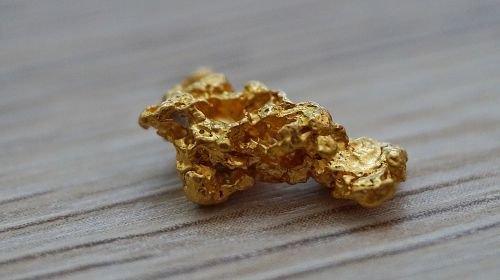Gold: What is it, Characteristics and Meaning
What is gold?
Gold
Gold is a chemical element with atomic number 79 and the chemical symbol “Au”. It is a soft, bright yellow metal found in a solid state in nature. The word gold derives from the Latin aurum , which means 'bright dawn'.
However, the term gold can also be used with other senses, among which its use as a synonym of wealth or wealth stands out to refer to the monetary value that this metal represents. For example, "Mr. Uslar distributes his gold with the most underprivileged in the city."
Gold as a chemical element and metal
 In the image you can see a gold nugget in its natural state.
In the image you can see a gold nugget in its natural state.
Gold is a chemical element that is located in group 11 of the periodic table, like silver and copper, and its symbol is “Au”.
It is a precious metal that is found in a solid and pure state both in the earth's crust and in the seabed and in rivers, although in small quantities.
Its extraction is carried out through the cyanide leaching process, however this technique is harmful and very toxic to the environment. However, in rivers the technique of batting is usually applied, which is less damaging to the ecosystem.
Gold is a soft, yellow transition metal that is characterized by being ductile. It keeps well thanks to the fact that it does not react with a large number of chemical compounds.
Likewise, gold has been the most widely used metal since ancient times, especially in handicrafts, for more than 5000 years. For example, there is evidence that ancient Egyptian civilizations knew and used gold in the making of various artifacts.
Therefore, since then, gold has been considered a precious metal of great value , which is why it has been used to mint coins, make jewelry and other handicrafts and luxury items of high monetary value.
Gold characteristics
The main characteristics of gold are:
- It has a bright yellow color in its pure state, but with alloys it can change a little tonality.
- It is a good conductor of heat and electricity.
- It is a metal that stands out for being very flexible and soft.
- It is a ductile metal.
- It has high resistance to oxidation and various chemical agents.
- It is a metal unalterable by air and humidity.
- It is a metal that reacts in chlorides.
- It is a dense metal with high degrees of melting and boiling.
Gold properties
The main properties of gold are the following:
| Atomic number | 79 |
| Chemical symbol | Au |
| Natural state | solid |
| Atomic mass | 196.966569 (4) u |
| Electronic configuration | [Xe] 4f 14 5d 9 6p 2 |
| Density | 19,300 kg / m 3 |
| Boiling point | 2856 ° C |
| Melting point | 1064 ° C |
| Oxidation state | 1+ and 3+ |
Uses and applications of gold
Gold is a metal that is widely used in various areas, especially in the area of jewelry, coin making, and the electronics industry. It is also part of the reserves and economic investments of the countries. The main uses include the following:
- Jewelry making, about 70% of the gold is used for this activity.
- Manufacture of coins.
- Manufacture of medals.
- In medicine it is used for the manufacture of therapeutic and cancer drugs.
- In cosmetics it is used in the preparation of facial creams.
- It is a metal used in the manufacture of aircraft engines.
- It is used as a protective coating in the manufacture of satellites.
- In dentistry, gold is used in the manufacture of dental prostheses.
- It is used in the manufacture of household items such as cutlery or plates.
- Thanks to its conductivity and resistance to oxidation, it is used in the manufacture of electrical connections.
- Its use has been extended to the health area for therapeutic purposes and in the manufacture of medicines.
- Update date: March 11, 2021.
Recommended Contents
- 50 defects of a person: from the least annoying to the most serious
- 60 examples of valuable qualities for life
- Artistic Vanguards: What is it, Characteristics and Meanings
- Characteristics of the vanguards: What is it, Characteristics and Meanings
- Combustion: What is it, Characteristics and Meaning
- Combustion: What is it, Definition and Meaning
- Compound: What is it, Characteristics and Meaning
- Conquest of America: What is it, Characteristics and Meanings
- Discovery of America: What is it, Characteristics and Meanings
- Multiple intelligences: What is it, Characteristics and Meanings
- Petroleum: What is it, Characteristics and Meanings
- Poetic function: What is it, Characteristics and Meaning
- Types of culture: What is it, Characteristics and Meanings
- Types of standards: What is it, Characteristics and Meanings
- Vanguard movements: What is it, Characteristics and Meanings